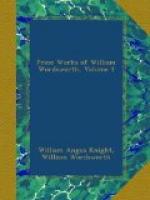[50] Anciently spelt Langden, and so called by the old inhabitants to this day—dean, from which the latter part of the word is derived, being in many parts of England a name for a valley.
Such, concisely given, is the general topographical view of the country of the Lakes in the north of England; and it may be observed, that, from the circumference to the centre, that is, from the sea or plain country to the mountain stations specified, there is—in the several ridges that enclose these vales, and divide them from each other, I mean in the forms and surfaces, first of the swelling grounds, next of the hills and rocks, and lastly of the mountains—an ascent of almost regular gradation, from elegance and richness, to their highest point of grandeur and sublimity. It follows therefore from this, first, that these rocks, hills, and mountains, must present themselves to view in stages rising above each other, the mountains clustering together towards the central point; and next, that an observer familiar with the several vales, must, from their various position in relation to the sun, have had before his eyes every possible embellishment of beauty, dignity, and splendour, which light and shadow can bestow upon objects so diversified. For example, in the vale of Winandermere, if the spectator looks for gentle and lovely scenes, his eye is turned towards the south; if for the grand, towards the north: in the vale of Keswick, which (as hath been said) lies almost due north of this, it is directly the reverse. Hence, when the sun is setting in summer far to the north-west, it is seen, by the spectator from the shores or breast of Winandermere, resting




